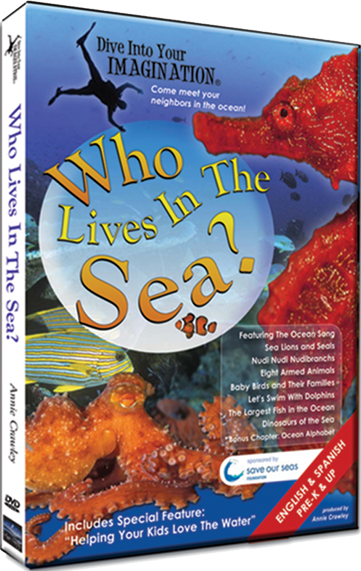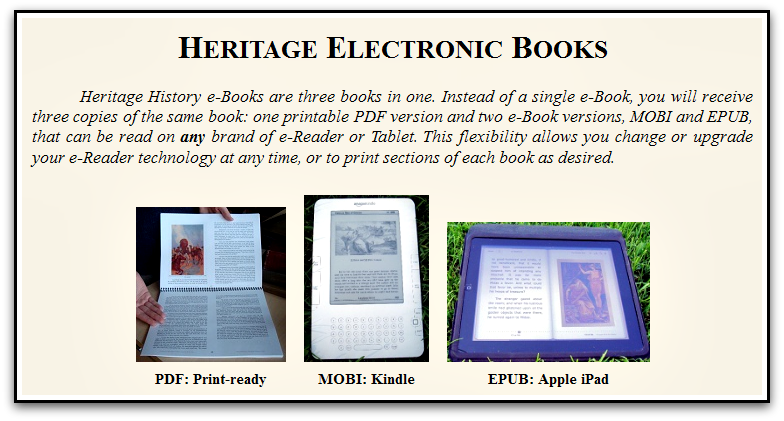Who Lives in the Sea is one of the educational DVDs by Annie Crawley--an underwater photographer, dive instructor, and boat captain.
This 45 minute DVD is filled with crisp, vivid and colorful glimpses that few of us will get to see in person. Each creature has it's own chapter on the disc, varying from 90 second to three minutes: dolphins, sea lions, sea turtles, marine birds, eight-armed creatures, whale sharks, and nudibrachs (sea slugs).
It's hard to learn much about a creature in under 3 minutes so there are also PDF teacher's guides available in two age levels, Pre-K/K and 1st-3rd grade. I have a third graders so he's just at the upper edge of the target audience and I be honest that he felt the video was a little too babyish for him--phrases like "An octopus has eight legs, can you count to eight?' So while we probably won't be watching the DVD over and over again, the PDF guides would make an excellent ocean unit study.
The audio can be English, Spanish, or just listen to the music and enjoy the scenery. There is no closed caption, but you can find transcripts on the disc under special features.
The DVD is $19.95 at the Dive Into Your Imagination website. You can also find video samples from the DVD. The other titles are Dive into Diversity and What Makes a Fish, a Fish. A PDF guide for one title is $69.95 --a hefty price tag, I know. But if you use the notes section of the order form to let Anne know that you're a home schooling family and follower of the TOS Homeschool crew she will send the PDF as a free gift.
Check out what other crew members thoughts about their videos by clicking here.
Disclaimer: I receiv3ed a free DVD and PDF files for the purpose of completing this review.
Thursday, May 31, 2012
Thursday, May 24, 2012
TOS Review: Heritage History
Temps in the high 70's, low humidity, blue skies with puffy white clouds. The weather this past week has been perfect for one of my favorite activities--sitting in the porch swing with a good book. The swing has been crowded as we've been visited by a cast of characters and historical figures: King Arthur, Joan of Arc, the Vikings, and Robinson Crusoe to name a few. All were brought to us the the Young Readers Classic Curriculum by Heritage History.
This one CD contains over 80 books in three formats: PDF, EPUB, and MOBI. It was very simple to load the MOBI versions onto my Kindle. Those without e-readers may print the texts or read them on the computer. I was reading aloud to my Schnickelfritz, who was often busy with a highway system done in sidewalk chalk, but the Young Readers books are appropriate for any child reading at the fourth grade level. If used as a curriculum, Heritage History recommends a student pick one book from each of its categories:
I think the Young Readers Curriculum would be great for a mom teaching unit studies or at least history to a wide age range of kids. Finding living books for older kids is easy, but my library doesn't have captivating stories about Joan of Arc, Napoleon, or Francis Drake for the elementary levels.
As a teacher/reader, I was less enthusiastic about a classic work that was re-written for younger readers. Robinson Crusoe Written Anew not only simplified the vocabulary but oversimplified the structure leaving short choppy sentences I wouldn't want my son to emulate. I also didn't feel drawn into the story--a real loss of description of surroundings and feelings. Take the following example:
We didn't read all the stories, and my perusal of the Stories of Beowulf showed it still used complex sentence structure and vocabulary (though not nearly so hard as the original). Bottom line--preread some of the selections yourself before assigning them to your kids. Here's the great news--you can actually read full versions of ALL the titles on the Heritage History website for FREE. (Or you can buy individual e-books for $1.99)
I also received a hard copy of the Teacher's Guide. My understanding is the Young Reader's version is much shorter than Guides for other Heritage History Curriculum. It includes a broad overview of the different historical divisions and summaries of the book titles within each division, but not the maps, timelines, and study aids as the guides for older readers. The hard copy Teacher's Guide $20.99, or it can be downloaded for $8.99, but it is also included free on the Young Readers Curriculum CD.
The Young Readers (and most other curriculum) are $24.99. Other titles are: Ancient Greece, Ancient Rome, British Empire, and British Middle Ages. The Christian Europe, Early American, and Spanish Empire titles are only $19.99. Right now Heritage History is running a Spring Curriculum sale--buy 2 and get 1 free! I don't know when the sale ends.
Other Homeschool Crew members reviewed other curriculum so you'll want to click here and see what they think of their titles.

Disclaimer: I received a free Young Readers CD and Teachers Guide from Heritage History for the purpose of completing this review. There was no other compensation for my honest opinions.
This one CD contains over 80 books in three formats: PDF, EPUB, and MOBI. It was very simple to load the MOBI versions onto my Kindle. Those without e-readers may print the texts or read them on the computer. I was reading aloud to my Schnickelfritz, who was often busy with a highway system done in sidewalk chalk, but the Young Readers books are appropriate for any child reading at the fourth grade level. If used as a curriculum, Heritage History recommends a student pick one book from each of its categories:
- American History
- Colonial Children
- European History
- Children's Heroes
- Ancient History
- Bible and Saint Stories
- Historical Anecdotes
- Legends and Folklore
- Twins of the World series
- Our Little Cousin Series
I think the Young Readers Curriculum would be great for a mom teaching unit studies or at least history to a wide age range of kids. Finding living books for older kids is easy, but my library doesn't have captivating stories about Joan of Arc, Napoleon, or Francis Drake for the elementary levels.
As a teacher/reader, I was less enthusiastic about a classic work that was re-written for younger readers. Robinson Crusoe Written Anew not only simplified the vocabulary but oversimplified the structure leaving short choppy sentences I wouldn't want my son to emulate. I also didn't feel drawn into the story--a real loss of description of surroundings and feelings. Take the following example:
No boat could live in such a sea at that. But we saw land ahead of us; and perhaps some of us might be cast alive upon the beach.
This was our only hope.
Now get a sense of how desperate the situation was in the Original
And now our case was very dismal indeed, for we all saw plainly that the sea went so high, that the boat could not live, and that we should be inevitably drowned...we worked at our oar towards the land, though with heavy hearts, like men going to execution for we all knew that when the boat came nearer the shore, she would be dashed in a thousand pieces by the breach of the sea. However we committed our souls to God in the most earnest manner; and the wind driving us towards the shore, we hastened our destruction with our own hands, pulling as well as we could towards land.
We didn't read all the stories, and my perusal of the Stories of Beowulf showed it still used complex sentence structure and vocabulary (though not nearly so hard as the original). Bottom line--preread some of the selections yourself before assigning them to your kids. Here's the great news--you can actually read full versions of ALL the titles on the Heritage History website for FREE. (Or you can buy individual e-books for $1.99)
I also received a hard copy of the Teacher's Guide. My understanding is the Young Reader's version is much shorter than Guides for other Heritage History Curriculum. It includes a broad overview of the different historical divisions and summaries of the book titles within each division, but not the maps, timelines, and study aids as the guides for older readers. The hard copy Teacher's Guide $20.99, or it can be downloaded for $8.99, but it is also included free on the Young Readers Curriculum CD.
The Young Readers (and most other curriculum) are $24.99. Other titles are: Ancient Greece, Ancient Rome, British Empire, and British Middle Ages. The Christian Europe, Early American, and Spanish Empire titles are only $19.99. Right now Heritage History is running a Spring Curriculum sale--buy 2 and get 1 free! I don't know when the sale ends.
Other Homeschool Crew members reviewed other curriculum so you'll want to click here and see what they think of their titles.

Disclaimer: I received a free Young Readers CD and Teachers Guide from Heritage History for the purpose of completing this review. There was no other compensation for my honest opinions.
Tuesday, May 22, 2012
Review: Write Shop C
 Of the three R's, the one we struggle with most in our home is 'Riting. My son has an active imagination and he's orally shared dozens of his own Hank the Cowdog stories with me, but he's loathe to put pencil to paper. WriteShop may be just the product we need--it actually encourages parents/teachers to write alongside or take dictation from their kids in 15-minute long lessons.
Of the three R's, the one we struggle with most in our home is 'Riting. My son has an active imagination and he's orally shared dozens of his own Hank the Cowdog stories with me, but he's loathe to put pencil to paper. WriteShop may be just the product we need--it actually encourages parents/teachers to write alongside or take dictation from their kids in 15-minute long lessons.
We used level C which is geared towards 7-8 year olds, but can be used with 9-11 year olds that struggle with writing. There are 10 lessons that can be done on a two week (4 days/week) or a three week (3 days/week) schedule.
WriteShop Primary's lessons are divided into six sections:
1. Guided Writing--you teach and model new skills. In lesson one this was a circular chart that teaches the ingredients of a good story are like the ingredients in a recipe.
3, Brainstorming--planning and organizing the writing project. We used paper cut outs of magnifying glasses (continuing our detective theme) with the Who, When, Why, etc. written on them. Then we wrote notecards answering those questions and developing the ingredients for our own story.
4. Writing Project--the main focus of every lesson. The child writes the story based on the brainstorming activity. This isn't a major work of fiction--just 7-12 sentences.
5. Editing and Revising--making simple improvements to the writing. Correct spelling and grammar errors and add any new details that the child would like.
6. Publishing the Project--creating the final draft. In this case (a little more detective lingo) we cut the final draft up into puzzle pieces so any future readers would have to work to discover the story.
Schnickelfritz didn't balk at the short lessons or my writing help. Some of the additional activities seemed babyish to him--analyzing the poem "Hickory Dickory Dock" for example. We entirely skipped the learning to tell time activity because he's known how to read a clock with dials for year's now. I realize this material is geared to younger children where the nursery rhyme and click activites are age appropriate.
The downloadible format of the Teacher's Manual retails for $28.95, the Student Worksheet set is $4.50 (hard copies are $$32.95 and $4.95 plus shipping). But there's a special offer until June 15th! Use the code CREW15 to save 15% on any Primary and Junior products in the WriteShop store.
Be sure to check the Homeschool Crew Blog. Other members had other levels of the program to review.

Disclaimer: I received free e-versions of the Level C Teacher's Manual and Student Worksheet set for the purpoase of completing this review. There was no other compensation for my honest opinions.
Saturday, May 19, 2012
M is for Movie Night
When I was a little girl, movies used to be special. You didn't get to go to the movies very often. There was no such thing as DVDs or VCRs, certainly no cable or satellite or streaming downloads. When we did go to the movies, you exercised some care about what you spent your money to see. Nowadays, the studios just seem to be cranking out flicks left and right--if they're not good enough to release in theaters (a very low threshold I might add) they can go direct to DVD.
We're fairly careful what films we allow into our home and into our eyegates if you will. And I'd like that experience to be special for the whole family. So this year we're kickin' it up a notch and starting a backyard theater. The Toolman stalked the online auctions and Dell's reconditioned sales site and found a bargain for a projector. We tested it out last night using read projection from the garage.
We couldn't set the projector right behind the screen because it created a "hotspot" right in the center of the shot. The projector allowed you to skew the image so that everything appeared dead on even though the shot was actually coming from about a 45 degree angle.
Eventually, we'd like to show movies projected on the front of our barn in the back yard. We've got a sloped hill that would make a natural amphitheater. Off to one side is our fire pit so we could have hot dogs and s'mores --a snack bar for the drive-in if you will.
I've got a long list of movies to share with family and friends. Epics like Ben Hur, old Disney flicks like So Dear to My Heart, comedies like Bringing Up Baby. Maybe we'll start a Friday Family Flicks review feature and I'll tell you how each one went over. Anybody have any films they'd like to recommend?
This M is for Movie Night is part of the Ben & Me's ABC Challenge. You can check out the other M topics by clicking here.
Friday, May 18, 2012
5 Days of Freezer Cooking (Day 5)
I couldn't end this week without sharing a few of my favorite freezer recipes. The first is my go to side dish for Thanksgiving the other is my workhorse recipes--it forms the base for 6-7 entrees.
Butternut Squash Casserole (makes 2 qts)
Aprox. 3 lb butternut squash 3/4 C sugar
3/4 C milk 3 T flour
6 T melted butter 1/2 t cinnamon
3 eggs, beaten 1/8 t ground cloves
1/2 t vanilla extract 1/8 t nutmeg
Topping (mix & freeze separately or make on serving day)
1/2 C crushed vanilla wafer cookies
1/4 C brown sugar
2 T melted butter
Assembly Directions
Peel squash, remove seeds and cube. Place squash in large sauce pan and cover with water. Bring water to a boil, then lower temp, cover and cook 25-30 minutes. Drain squash and place in mixing bowl. Beat until smooth (for really smooth pulp use a food processor). Add milk, butter, eggs and vanilla and mix well. Combine sugar, flour, and spices and add to squash mixture. Mix well and transfer to freezer container (you can use a gallon freezer bag). If you make the topping today, mix wafers and brown sugar and put in a quart size freezer bag and attach to the squash bag.
Cooking directions
Thaw completely overnight. Pour the squash into a greased 2 qt baking dish. Cover and bake at 350 for 45 minutes. Meanwhile melt 2 T of butter and combine with wafer crumbs and brown sugar. Remove the squash, sprinkle with topping. Return to the oven and bake uncovered for 12-15 minutes.
Big Batch Beef Sauce (makes 6-7 two-cup batches)
4 lbs ground beef 1 T salt
4 medium onions, chopped 2 t oregano
4 garlic cloves, minced 2 t basil
84 oz crushed tomatoes 1 t pepper
12 oz tomato paste 1/2 t crushed red pepper flakes
9 oz mushroom pieces
1 T dried parsley
Assembly Directions
In a large dutch oven (I use a 8 qt) cook beef, onions, garlic over med heat until meat is no longer pink and veggies are tender. Drain. Stir in remaining ingredients. Bring to a boil, reduce heat and simmer 60-90 minutes, stirring occasionally. Cool and transfer to qt freezer bags (about 2 cups in each).
Cooking Directions
Thaw 1 bag of beef sauce for use in one of the following recipes.
Tacos
Combine beef sauce with 1 envelope taco seasoning and 1/4 C water. Simmer until heated through. Serve on soft or hard taco shells. Top with lettuce, cheese, tomatoes, sour cream, etc.
Spaghetti
In a sauce pan combine beef sauce with 8 oz tomato sauce and 2 t Italian seasoning. Serve over hot, cooked spaghetti.
Chili
In a sauce pan combine beef sauce, 1 can kidney beans (drained), 2 T chili powder, and 1/4 crushed red pepper flakes. Bring to a boil then simmer until heated through. Garnish with shredded cheese, onions, etc.
Shepherd's Pie
In a bowl combine 1 cup mashed potatoes, 2 grated carrots, 1 can corn, 1 T onion soup mix. Spread in a greased 2 qt baking dish. Top with beef sauce and another 2 cups mashed potatoes. Sprinkle with Parmesan cheese. Bake uncovered at 350 for 40-50 minutes.
Tangy Beef Salad
Heat beef sauce. In a large bowl shred 6 cups lettuce. Add diced green pepper, chopped onion, a chopped tomato, 1 can (drained) kidney beans, 1 C shredded cheddar cheese. Top with beef sauce. Drizzle Catalina dressing on top and sprinkle with crushed corn chips.
Beefy Vegetable Soup
In a large saucepan combine beef sauce, 3 C tomato juice, 2 cans beef consomme, 2 cubed potatoes, 2 grated carrots, 1 cup peas, 1 t sugar. Bring to a boil. Stir in 1/4 C uncooked long grain rice. Reduce heat, cover and simmer 20-25 minutes or until veggies and rice are tender.
I hope you've enjoyed my 5 Days of Freezer cooking as well as the rest of the Blog Hop. If you haven't yet, please choose one of the many methods for following Ozark Ramblings.
If you've missed any of the other "5 Days of ..." blogs, click below.
Thursday, May 17, 2012
5 Days of Freezer Cooking (Day 4)
I’m assuming now that you’re doing the mini or big batch method—if your just doubling up you won’t need any special instructions.
The Night Before
Whatever you can get done tonight is one less thing that needs to be done in the morning. Hagve anything that needs to marinade? Why not brown the ground beef? In the morning you’ll be able to assemble dishes with cold meat which will be less taxing on your freezer. Chop the onions and peppers. Shred the cheese. Most of the freezer cookbooks I have contain a recipe substitution for “cream of whatever” condensed soup. If you’re using that instead of buying cans, make this the night before. I pour mine back into the milk jug once it’s prepared—just fill the jug up to the point where the walls of the jug are still straight. After it’s cooled it will thicken and congeal and be impossible to pour so on assembly day cut off the top of the jug and you’ll be able to scoop out the contents. If a lot of your recipes call for cooked, chopped chicken consider throwing the meat in the crock pot over night. In the morning you’ll just need to let it cool so you can debone and chop it up.The Big Day
My most recent cooking day was at my mothers. We assembled 15 meals each of 3 different recipes so this would really qualify as a mini-session. We made meatloaf muffins, a creamy shredded chicken dish, and Parmesan chicken. I arrived with baggies of chopped veggies and premixed coating to dredge the chicken in. We had good conversation and laughs and were done in about 2 hours. The following is really a list of tips rather than a description of an assembly day.Set up “stations” around the kitchen—chopping, measuring, bagging, etc. Keep hot, soapy water in the sink. When you use a measuring spoon or cup, clean it and return it to the measuring station so you’ll be able to find it quickly for its next use.
Start the most time consuming or labor intensive dishes in the morning while you’re still fresh. You don’t want to get to the end of the day and discover you need to stuff 200 pasta shells.
Work through one protein type at a time and wash measuring tools and equipment well in between to avoid cross contamination.
The National Center for Home Food Preservation does not recommend thawing raw meats and refreezing them in their raw state so if you use frozen ground beef or frozen chicken breasts you'll want to cook the dish before freezing it again.
Line cookie sheets and baking pans with aluminum foil to make clean up faster & easier with greasy dishes. For non greasy foods, I like to use Quillon paper (available at restaurant supply stores).
Store foods in sizes that work best for your family. Consider individual portions that can be taken to work or school.
 |
| From The Big Book of Freezer Cooking |
I like to store as much as possible in freezer bags (this obviously won't work with lasagna or pot pies). Remove as much air as possible to prevent freezer burn. If you don't have a vacuum sealer try submersing all but the top of the bag in water before you seal it. Or seal most of the bag and insert a soda straw to suck the air out before completing the seal.
Tomato based foods can react with aluminum foil (making small holes) so I'd wrap in plastic first and then foil if necessary.
If you only have one 9 X 13 dish and you use it to freeze a lasagna, you won't have it to bake with again until you eat that dish UNLESS you place plastic wrap in the bottom of the pan before assembling the dish. Once its frozen solid you can remove it from the pan and store it in more plastic wrap or a bag.
Label everything before you put it in the freezer. After being in the freezer for a month and started to be covered with ice crystals, frozen foods tend to start looking alike. A friend found out the hard way when she meant to grab pizza sauce and got sweet and sour chicken instead. You can buy grease pencils to write on plastic or freezer tape where you find canning supplies. Don't use regular masking tape as it tends to fall off in the freezer.
Let hot dishes cool before you put them in the freezer so you don't tax the thermostat. Try to spread them out over the entire space to give each dish a chance to freeze quickly.
You CAN fit 30 meals in a standard refrigerator freezer if you store in bags.
 |
| From The Big Book of Freezer Cooking |
We've got one more day to go and I'm sharing two of my favorite recipes with you. If you're enjoying the series please consider following Ozark Ramblings with one of the options to the right. And here's the link to take you back to the 5 Days of Blog Hopping.
Wednesday, May 16, 2012
5 Days of Freezer Cooking (Day 3)
If you’re like me you already have a drawer full (really more like a cupboard full) of recipes. Why do you need more? Well, some things fare better in the freezer than others. Wanna try a science experiment—see what happens to lettuce or a cucumber in the freezer. Cooked whole wheat pasta just disintegrates and leaves a grainy texture in the dish. I want you to be successful with your first freezer cooking adventure, so lets start with some tried and true dishes. Fortunately, freezer cooking is not a new concept—there a plenty of books and Internet sources .
Books
Once-a-Month Cooking
Mimi Wilson & Mary Beth LagerborgThis is the book that started it all for me. I heard Mimi speaking on Focus on the Family more than a decade ago and ordered her book. Once a Month cooking has gone through several editions and new recipes have been added each time. In the latest version the focus seams to be on freezing recipes that can be cooked in the crockpot on serving day. We’ll talk about this more tomorrow on planning strategies, but just note that OAMC uses the “big cooking day” method. This means that the grocery lists and assembly instructions will enable you two freeze two or four weeks of different dinner entrees—no duplication, in one cooking day. If you family just won’t it one of the dishes, you’ll have to manually remove its ingredients from the shopping list. On the other hand, if your family loves one of the dishes, they’ll have to wait until you prepare that plan again.
The book is very detailed for the newbie freezer cook. In addition to the grocery shopping list is a list of staples they expect you to have on hand. Then comes the list of freezer containers, how many and what with what dishes they’ll be used. There is a list of tasks to be done the day before cooking day, at the start of cooking day and step by step instructions on the order of assembling dishes broken down by protein type. Each recipe has an ingredient list, cooking instructions, a summary of processes (chop, grate, etc), freezer container to use, and suggested side dishes.
Some of my favorite recipes from this book (your edition may vary) are:
- Chicken Broccoli
- Chicken & Rice pilaf
- Pizza Roll-ups
- Ravioli Soup
30 Day Gourmet’s Big Book of Freezer Cooking
Nanci Slagle and Carol SanteeRight away I like this book because it has color photos of each recipe! This is the latest cookbook by 30 Day Gourmet (older editions were called the Freezer Cooking Manual from 30 Day Gourmet) . The first section of this book helps you decide which cooking day method will work for you (big cooking, mini-batch, etc). Since you decide the method, they can’t provide grocery lists or assembly instructions for you, but they do provide blank worksheets for you to fill out yourself: A tally sheet to add up ingredients needed, a shopping list, pre-assembly day and assembly day instructions, a recipe inventory checklist, and a sheet to figure out multiples of a recipe.
Recipes are organized by categories: Beef, Poultry, Pork & Fish, Meatless, Breads & Breakfast, Soups & Sandwiches, Sides & Salads, Sauces & Marinades, Appetizers, Snacks, Desserts
As you can see, these folks believe freezer cooking is for more than just the main entree at dinner. (It was their holiday cookbook that allowed me to freeze my entire Thanksgiving meal when Schnickelfritz was born). This is where I get most of my recipes—in fact I’ve purchased their software which will create shopping lists and assembly day instruction reports for me based on the recipes I select. Some of my favorite recipes are:
- Wet Tacos
- Spaghetti Pie
- Cheddar Broccoli Soup
- Parmesan Parsley Chicken
Other Books
I’ve checked out many other freezer cooking and copied a recipe or two. Most of these books list the original recipe and then list the ingredients needed to make multiples of of the recipe. Here are a few titles I recommend: Don’t Panic, Dinner’s in the Freezer; Dream Dinners, Frozen Assets, Freezer Pleasers.Magazines
Quick Cooking magazine always had a section called Freezer Pleasers. This is where I found my Big Batch Beef Sauce recipe and all its variations. I have noticed that the submissions tend toward the desserts. This magazine is now called Simple & Delicious and I don't know if they still have the freezer section. Check out old copies at your library or perhaps you can find the compilation book—Taste of Home’s Freezer Pleasers. I’ve also seen Taste of Home Freezer recipe mini magazines near the check out stand at the grocery store ( I like these because they have pictures of each recipe).Internet
30 Day GourmetThis is the website home of the Big Book of Freezer Cooking folks. You can purchase their book and software. They also have several specialized ebooks for download – Vegetarian, Lunches, Holidays, Desserts, Lowfat, and Budget meals. Sign up for their newsletter and they’ll send you recipes every month. Purchase one of their books and you’ll find a password to unlock more recipes and downloads of their worksheets in the members area. Their message boards is a place to ask questions or share assembly day stories with others.
Once a Month Mom
I just came across this site while researching my 5 Days of Freezer Cooking and I must say I'm impressed! She doesn't just provide one 30 day meal plan each month, but SIX! In addition to traditional meals you can find plans for Whole Foods, Diet, Gluten/Diary Free, Baby Foods, and Vegetarian meals. You can print out grocery lists, recipe cards, even labels for your storage containers that list the recipe, serving day instructions and nutrition (they are designed to be printed on Avery labels but I don't know how well these will stick in the freezer). I'll be checking this site out more thoroughly. I also noticed that they're always looking for test cooks.
30 Day Cafe
This website combines a few ideas--freezer cooking, crockpot/slow cooker meals, and canning/preserving. There's a free downloadable collection of forms to help you organize your menu and assembly day. Most of the recipes have photos.
Your Own Recipes
Freezer cooking doesn't mean giving up you family favorites. Sometime when you make your specialty, take one serving and wrap it well and place it in the freezer. After a week or so, take the dish out, defrost it and reheat it. If it tastes all right and the texture is still good, you may have a candidate for a freezer dish. Even if its not right you may be able to assemble parts of the dish uncooked and finish the job on serving day. I have a Mexican Lasagna dish that falls into this category--if I assemble it complete the tortillas in the middle absorb too much liquid and fall apart. I can make the meat mixture and freeze it alone though. When I want to cook Mexican Lasagna I just thaw the meat and layer it up.
Okay, if your following along you know your reasons for freezer cooking, you've planned you assembly method and now you know where to find some recipes. Come back tomorrow for Assembly Day (or better yet sign up to follow Ozark Ramblings).
Until tomorrow then, check out some of the other "5 Days of...." topics by clicking below.
Tuesday, May 15, 2012
5 Days of Freezer Cooking (Day 2)
Approaches to Assembly Day
I can think of three different ways of assembling freezer dishes. Only you know which one will work best for your family. I will list them in order from least intimidating to most.
 1. Doubling Up: You know what you want to make for supper tonight, but instead of making just one chicken pot pie, you're going to buy enough ingredients to make two. You'll eat one tonight, but the other you will assemble and put in the freezer for another day. Or perhaps you make more chili or soup than your family could possibly enjoy before it spoils (or they get sick of leftovers). Pour some in freezer bags for later. I do this all the time with Broccoli Cheddar soup and I store it in individual servings. It makes an easy lunch to pull out one and serve it with a sandwich.
1. Doubling Up: You know what you want to make for supper tonight, but instead of making just one chicken pot pie, you're going to buy enough ingredients to make two. You'll eat one tonight, but the other you will assemble and put in the freezer for another day. Or perhaps you make more chili or soup than your family could possibly enjoy before it spoils (or they get sick of leftovers). Pour some in freezer bags for later. I do this all the time with Broccoli Cheddar soup and I store it in individual servings. It makes an easy lunch to pull out one and serve it with a sandwich.2. Mini Sessions: You see that boneless, skinless chicken breasts are on sale at a fabulous price so you pick up several pounds worth. You scan through your recipes for those calling for chicken breasts or cooked/chopped chicken and plan to assemble 5-10 chicken recipes on Saturday afternoon. This is sometimes called cooking by protein type or loss leaders. To help plan for this method I developed my own Recipe Organizer pages. There's a specific column to mark freezable dishes.
Recipe Organizer Printable
The benefits here are financial savings. If you only buy what's on sale and you stock up enough to last till the next sale you'll be set. A disadvantage is that until you go through a cycle of meat sales you may have a freezer full of chicken dishes and everyone wants beef.
I suppose a mini-session could be just a batch of 4-6 recipes of various meats as well. The book Once a Month Cooking offers two-week plans in addition to 30 day plans.
3. Big Batch Cooking: You've got on your most comfortable shoes. The kids are staying at grandma's house. And your not leaving the kitchen until you've put up 30 dinners or more. One shopping trip, one assembly day, and you don't have to do it again until next month. The originators of 30 Day Gourmet used to assemble 75-80 entrees every three months. The key to this method is planning, planning planning. (I'll confess I've never done 30 meals, but I have done 14).
The More the Merrier or Too Many Cooks Spoil the Broth
Your next decision will be whether you want to tackle this alone or work with a friend/relative/neighbor. Up until this year I've always done freezer cooking alone. I could start when I wanted to, work in the order I wanted to, spice the food as I wanted to. Recently though, my mother moved down the road from me and we did a mini session together. We still got the work done, but it didn't seem so tedious with someone to talk to.
She could be washing dishes (a task she doesn't mind) while I was assembling something else. We could both tackle a mountain of onions that needed chopping rather than me doing it alone. If your a freezer cooking newbie, you might want the safety net of someone who has a few assembly days under her belt. Two cooks can mean two crock pots or an extra set of measuring tools so you don't have to stop and wash as frequently.
On the other hand, if you work with someone else you'll need to figure out a way to divide the costs, and the tasks. One person will have to be willing to haul her bowls and tools to the other's house. If you decide to each make 10 dishes and split them with each other, you'll have to put up with the other's taste in spices. The work load goes down the more people work together, but the complications may go up.
Preparations
Gather Your Tools
If you have the equipment needed to fix dinner in you house, you have all the tools necessary to fix freezer meals.
- Large bowls
- Measuring Cups and Spoons
- Kitchen timers
- Hand held or stand mixer
- Freezer bags or hard-sided containers
If you're planning to cooking the Big Batch method, there are a few items that can greatly increase your efficiency. If you have a birthday, anniversary, or Christmas is coming up you might suggest someone get you--
- A food processor to help with the chopping
- An electric can opener (trust me, you'll be opening a lot of cream of whatever cans)
- A second set of measuring tools
- A vacuum sealer
- A professional chef's mat to stand on
I would strongly advise you NOT to shop for ingredients on Assembly day. It will just delay your start and make the day seem that much longer. This means you'll need space to store perishables in your fridge at least overnight. After assembling the dishes you'll want to space them to allow the freezer to work efficiently (after they're frozen you can stack bags/containers to make room for the ice cube trays and store-bought frozens). So the week before an assembly day is the time to use up leftovers, defrost the freezer, etc. I'm fortunate to have a second fridge/freezer downstairs so I can devote one to holding assembly day perishables and really spread out my dishes for freezing.
Check your staples
When reviewing your recipes and writing grocery lists don't assume that you have enough of any ingredient just because its a staple in your pantry. Count how many cans of tomato paste are in the cabinet. Peer into the spice canisters to see if there's enough oregano. There's no bigger train wreck on assembly day than discovering the egg carton really only has 4 eggs left instead of a dozen . If you have teenagers that forage for themselves in the kitchen you might want to put colored stickers on cans that you're saving for assembly day. Let them know that red dots mean off limits.
 |
| From The Big Book of Freezer Cooking |
Are you feeling motivated yet? Take some time to decide if your going to assemble alone or with others. Will you fill your freezer gradually or do one big batch of freezer meals? Evaluate your kitchen equipment and see if you've got the necessary tools on hand. Now, what will you prepare? We'll talk about that tomorrow with Finding Recipes in our 5 Days of Freezer Cooking. Don't forget to follow Ozark Ramblings by one of the methods to the right.
There are plenty of other "5 Days of..." blogs to check out! Just click below.
Monday, May 14, 2012
L is for Lego League
Normally when I blog, I try to write about something I'm very familiar with. Today's L in Ben and Me's Alphabet Challenge is actually something I want to learn more about myself. A few weeks ago, Schnickelfritz and I went on an adventure (code of field trip) to the FIRST Robotics Championships in St. Louis. Although the glitz and glamor went to the 14-18 year olds building basketball shooting robots, there was a minor leagues version for up and coming programmers and engineers. FIRST's Lego League is a world wide competition for 9-14 year olds.
Each Annual Challenge is made of three parts: The Project, the Robot Game, and Core Values. I'll share what I've discovered about the 2012 Challenge: Food Factor (each year has a new theme).
The Project
The students had to:
- Identify a problem associated with food safety.
- Research a solution that is either a new idea or improvement on something already being done.
- Create an innovative solution for safely harvesting, transporting, preparing, or storing certain foods.
- Share their solution with their community
- Make a 5 minute presentation before a panel of judges
The Robot Game
Each team has about 10 weeks to build and program a Lego Mindstorm robot that can navigate the playing field and perform tasks: drop off loads, pick other loads up, turn a dial, pull a wagon etc. Each task has a point value based on difficulty and distance from the base corner. I believe there are 300 points available in a 2 minute 30 second match. Here's the kicker--the kids have to design, build, and program their robots themselves. They have to learn about sensors and a programming language. Coaches are encouraged to help students experiment to discover what works best but they're strictly hands off the robot. All decisions are to be made by the kids.Core Values
I couldn't say this better than they do themselves, so I'm copying this from the FIRST Lego League website.The FLL Core Values are the cornerstones of the FLL program. They are among the fundamental elements that distinguish FLL from other programs of its kind. By embracing the Core Values, participants learn that friendly competition and mutual gain are not separate goals, and that helping one another is the foundation of teamwork.
I'm attending an informational meeting to learn how to coach a Lego League team myself, so I hope this is this first of many FLL posts. In the meantime I'll keep blogging through the alphabet.
5 Days of Freezer Cooking (Day 1)

Benjamin Franklin had it wrong. Death and taxes aren’t the only certainties in life. Any wife or mother will tell you the third certain thing is someone asking “What’s for supper?” Everyone needs to eat, but how we go about preparing meals for our families can vary widely. Do you throw open the cupboards at 4 pm and hope to be inspired? Perhaps your the planning sort that pulls out the cookbook and the grocery inserts from the paper and chooses the meals for the week? Do you like to cook or do you hate it? This week I’d like to share with everyone the concept of freezer cooking. Today I’ve got four good reasons why it can be a benefit to you.
Freezer Cooking can save you money
In these tough economic times, I’m pleased to announce that freezer cooking will save you money! If you have a dinner you can pull out of the freezer that means you don’t have to order pizza in or head to the drive thru. Have you checked the prices lately? A pizza for a family of four runs $18-$20 (and that’s not counting the tip for the delivery man). Last year I figured out the cost for ingredients for a home made pizza at under $1.27. The remaining cost is for the convenience of not cooking yourself (or perhaps the cost for not planning ahead).Beyond the savings of home vs restaurant, you can take advantage of bulk purchases or store sales. A can of crushed tomato sauce at my local Walmart is $.59 for 8 oz or 7.4 cents per ounce. I can buy a #10 can (96 oz) of crushed tomatoes for $2.79. That works out to just under 3 cents per ounce--less than half the cost!! When Thanksgiving rolls around and turkeys go on sale I buy the biggest one I can find. What doesn’t get eaten at the feast is used in freezer meals that call for cooked, chopped chicken. You can plan the same way with ground beef sales around the summer picnicking holidays.
Freezer cooking can be a real time saver.
Mary Hunt gave the best analogy when I attended her freezer cooki ng lecture at the Indiana Association of Home Educators: Imagine you needed to wash and iron a laundry basket full of shirts. You don’t take one shirt, throw it in the washer, move it to the dryer, iron it, and then return to the basket to repeat the steps with the next shirt. Half the work (or more) in cooking is the preparation and clean up. If you make enough meatloaf to fill two pans, serve one, and freeze the other you’ve made two meals but only have to goush (that’s a culinary term for squish it in your hands) the meat and clean the bowl once. Now imagine expanding your mega-cooking session to prepare a week’s worth of meals, or more. Two of my favorite freezer cooking resources are Once a Month Cooking and 30 Day Gourmet. Imagine the satisfaction of having a month’s worth of dinners in the freezer. I feel like I’ve gained 4 extra hours to my day when I know in the morning the dinner’s already taken care of. Even if I have some additional prep work before I pop dinner in the oven, I know I’m coming out ahead. One of my favorite recipes is Big Batch Beef Sauce. I make 7-8 meal servings at a time and store it in quart freezer bags. When I thaw one I can use it as the base for several dishes: spaghetti, chili, taco salad, shepherds pie, etc. Sometimes I think that even better than saving time is saving the hassle of trying to figure out what meal I can put on the table.
ng lecture at the Indiana Association of Home Educators: Imagine you needed to wash and iron a laundry basket full of shirts. You don’t take one shirt, throw it in the washer, move it to the dryer, iron it, and then return to the basket to repeat the steps with the next shirt. Half the work (or more) in cooking is the preparation and clean up. If you make enough meatloaf to fill two pans, serve one, and freeze the other you’ve made two meals but only have to goush (that’s a culinary term for squish it in your hands) the meat and clean the bowl once. Now imagine expanding your mega-cooking session to prepare a week’s worth of meals, or more. Two of my favorite freezer cooking resources are Once a Month Cooking and 30 Day Gourmet. Imagine the satisfaction of having a month’s worth of dinners in the freezer. I feel like I’ve gained 4 extra hours to my day when I know in the morning the dinner’s already taken care of. Even if I have some additional prep work before I pop dinner in the oven, I know I’m coming out ahead. One of my favorite recipes is Big Batch Beef Sauce. I make 7-8 meal servings at a time and store it in quart freezer bags. When I thaw one I can use it as the base for several dishes: spaghetti, chili, taco salad, shepherds pie, etc. Sometimes I think that even better than saving time is saving the hassle of trying to figure out what meal I can put on the table.Freezer cooking can prepare you for a rainy day
 We all have those days or weeks when freezer meals are the only way a home cooked meal can happen. Maybe you’re in charge of VBS or the Easter pageant. Maybe you’ve got a garden full of tomatoes that need to be picked and canned. Or maybe you’re like me when my Schnickelfritz was born: I had a newborn baby, two weeks later I had surgery and my hand was immobilized and my husband had double knee surgery. Yes, we did have friends bring over a few dinners when the baby arrived, but who ever thinks you might need help with breakfasts? Fortunately I knew all these events were going to occur so in the prior month I was cooking and freezing up a storm. Everyone was so amazed that I was able to host Thanksgiving dinner during that period. We may have eaten on paper plates, but the meal itself went into the freezer when everyone else was thinking about carving their Halloween pumpkins.
We all have those days or weeks when freezer meals are the only way a home cooked meal can happen. Maybe you’re in charge of VBS or the Easter pageant. Maybe you’ve got a garden full of tomatoes that need to be picked and canned. Or maybe you’re like me when my Schnickelfritz was born: I had a newborn baby, two weeks later I had surgery and my hand was immobilized and my husband had double knee surgery. Yes, we did have friends bring over a few dinners when the baby arrived, but who ever thinks you might need help with breakfasts? Fortunately I knew all these events were going to occur so in the prior month I was cooking and freezing up a storm. Everyone was so amazed that I was able to host Thanksgiving dinner during that period. We may have eaten on paper plates, but the meal itself went into the freezer when everyone else was thinking about carving their Halloween pumpkins. Freezer cooking can allow you to practice hospitality
 Speaking of holiday meals or having babies, don’t you wish you had a meal you could just pull out the the freezer to share with a new mom, or a new neighbor, or to express your sympathy to a family suffering a loss? Maybe instead of bringing it over piping hot, you could deliver a frozen meal with cooking instructions and then they can use it according to their needs (I know when Schnickelfritz was born we had plenty of leftovers in the fridge when another new meal was delivered). Perhaps you could organize a freezer meal shower for a mom with lots of other kids that needs more free time than more baby clothes? I’ve even heard of a group of church ladies that met regularly to be a blessing for a fellow church member with muscular dystrophy. She supplied the grocery list and the money and they shopped and prepared the meals in individual serving portions for her to heat up. Talk about being God’s hands and feet for someone in need!
Speaking of holiday meals or having babies, don’t you wish you had a meal you could just pull out the the freezer to share with a new mom, or a new neighbor, or to express your sympathy to a family suffering a loss? Maybe instead of bringing it over piping hot, you could deliver a frozen meal with cooking instructions and then they can use it according to their needs (I know when Schnickelfritz was born we had plenty of leftovers in the fridge when another new meal was delivered). Perhaps you could organize a freezer meal shower for a mom with lots of other kids that needs more free time than more baby clothes? I’ve even heard of a group of church ladies that met regularly to be a blessing for a fellow church member with muscular dystrophy. She supplied the grocery list and the money and they shopped and prepared the meals in individual serving portions for her to heat up. Talk about being God’s hands and feet for someone in need! So have I convinced you to give freezer cooking a try? You’ll want to check back tomorrow when I share how to go about planning an assembly day. In fact, why not use one of the means in the right column to follow Ozark Ramblings. Until tomorrow you can check out one of the other Homeschool Crew's "5 Days of..." topics by clicking below.
Sunday, May 13, 2012
Review: Go Science
Our latest review products came from Library and Educational Services or LES--a company I often buy from. They have great prices on radio theater Cd's, Bible studies, flannel board figures, and more. In fact when I heard they were shipping me these two DVDs, I asked if I could add a few more purchases to the box. The review items are two volumes from a series called GO Science. Each DVD is about 40 minutes long and contains 9-12 demonstrations.
Do your kids like explosions? Would you rather view them safely on the TV than try to set them up in your basement? I was perfectly happy to let Ben Roy show what happens when you put a lit match under a balloon filled with hydrogen or cap a bottle filled with liquid nitrogen. Other demonstrations were of a much tamer nature: a study about buoyancy with two cans of root beer or seeing how many chicken eggs could fit inside an ostrich egg.
Did you know you can boil water over a flame in a paper cup? What do you think happens to common objects in the frozen blackness of space? The first half of this DVD covers experiments with water, the second half deals with outer space. There's even the trick we've probably all tried--swinging a bucket of water over our head without spilling.
First, I have to say that my son loved these videos. He felt like he was one of the students in the audience--going so far as to raise his hand hoping to get picked to answer a question. Ben Roy's bubbly enthusiasm for science (and kids) spills off the screen. I love his tag line, "Every time we learn about science, we learn something about our Creator--God." As an introduction to science, these videos are great when you're still trying to develop that sense of wonder and show that learning can be fun. Mr. Roy also covers important safety issues like using safety glasses and never sniffing beakers of unidentified chemicals.
As a teacher though, I don't think these videos go far to log as science for older kids (the recommended age range is 6-14). These are really "demonstrations" not "experiments." There is no hypothesis, and sometimes even no explanation for what we see. In the case of the exploding bottle we're simply told that it contains a "dangerous gas" but we never learn what that gas is. Similarly we don't learn what two chemicals are combined to create luminescence in the test tube.
You might want to consider using these DVDs in Sunday School or VBS. Each demonstration ends with a reference to how perfectly God created our world, or the dangers of sin, or how God can forgive our sins. It goes back to the tag line "Every time we learn about science, we learn something about our Creator--God." There is a feature to select chapters on the DVD so you could choose the demonstration that best firsts you Bible lesson. If you show them for a class please note there are no captions available. You can view a sample for yourself.
As I mentioned, these volumes are part of a series. Other titles include Magnetism, Simple Machines, Flight and Motion. LES offers these videos at a significant savings($8.97 vs $14.95) to qualified buyers (resellers, educators, librarians, home educators, as well as church leaders such as pastors or directors of children’s ministries.)
Others on the Homeschool Crew viewed the other titles so you'll want to click here and see what they think.
Disclaimer: I received two free Go Science DVD's for the purpose of completing this review. I received no other compensation for my honest opinions.
Friday, May 11, 2012
It's Coming ....Monday
A first for the Homeschool Crew Blog Cruise (and me). For those who follow the Cruise, you know that we tackle answering a different question each week. We all have the same question, but our answers can come from any number of directions. Next week, we'll each be spending a WHOLE week blogging about topics that our near and dear to our hearts...that we have a passion to share with others. I've seen the list and we're blogging about Adoption, Math, Living Books, Scouting, Homeschooling at Theme Parks and more. My topic for the week---5 Days of Freezer Cooking. Look for it Monday morning.
Monday, May 7, 2012
You must remember this....
Does the scene from Casablanca play in your head when you see those lyrics? My memory (or lack thereof) was highlighted yesterday. Schickelfritz and I went with his grandparents on a lovely drive through the country to an all you can eat fried chicken and pork steak dinner hosted by the VFW. To amuse himself (at the old folks' expense) he pulled the highway atlas out and began playing "Name the capital." Between the three of us we could usually come up with a correct answer (Carson City, Nevada stumped us all). We're in good company though, the NATO video promoting the upcoming summit stated Chicago was the capital of Illinois. It was considerably easier when he said the city and we had to come up with the state. Of course after 50 states and still some miles to go he turned to the Canadian Territories and Provinces. "Foul!" I cried, "I never had to learn those in school." My best guess was to add "City" to the end of whatever province he named (which only worked for Quebec).
We had a lot more laughs than correct answers--I can't tell you how bad it got when we switched to Mexico. It reminded me of watching "Are You Smarter Than a Fifth Grader?" I'm sure it was covered somewhere in my education, but those files have been pushed to the back of the cabinet in my mind to make room for "Where are my car keys?" and "Have I paid all the bills this month?" Anything I really need to know I can look up--although what you see in print isn't always true either. The Route 66 placemat my son has says Springfield, IL is the birthplace of Abraham Lincoln.
As a homeschooler I try to come up with fun and innovative ways to present information. Taking a field trip to a cave or battlefield, doing a hands-on project, are much more memorable than just reading a book.
I spend a lot of time trying to fill my son's head with facts--multiplication tables, dates from history, the taxonomy of a leopard, don't take candy from strangers. What sticks should serve him well some day. But the one thing I hope he remembers from his childhood is that I love him and God loves him more.
You can read how other Homeschool Crew answer the question "What’s the one thing you hope your children remember from their childhood?" by clicking here.
We had a lot more laughs than correct answers--I can't tell you how bad it got when we switched to Mexico. It reminded me of watching "Are You Smarter Than a Fifth Grader?" I'm sure it was covered somewhere in my education, but those files have been pushed to the back of the cabinet in my mind to make room for "Where are my car keys?" and "Have I paid all the bills this month?" Anything I really need to know I can look up--although what you see in print isn't always true either. The Route 66 placemat my son has says Springfield, IL is the birthplace of Abraham Lincoln.
As a homeschooler I try to come up with fun and innovative ways to present information. Taking a field trip to a cave or battlefield, doing a hands-on project, are much more memorable than just reading a book.
I spend a lot of time trying to fill my son's head with facts--multiplication tables, dates from history, the taxonomy of a leopard, don't take candy from strangers. What sticks should serve him well some day. But the one thing I hope he remembers from his childhood is that I love him and God loves him more.
You can read how other Homeschool Crew answer the question "What’s the one thing you hope your children remember from their childhood?" by clicking here.
Subscribe to:
Posts (Atom)



























